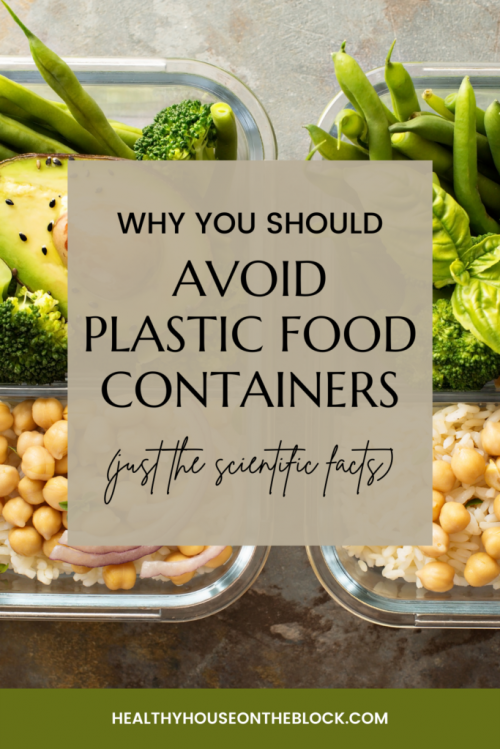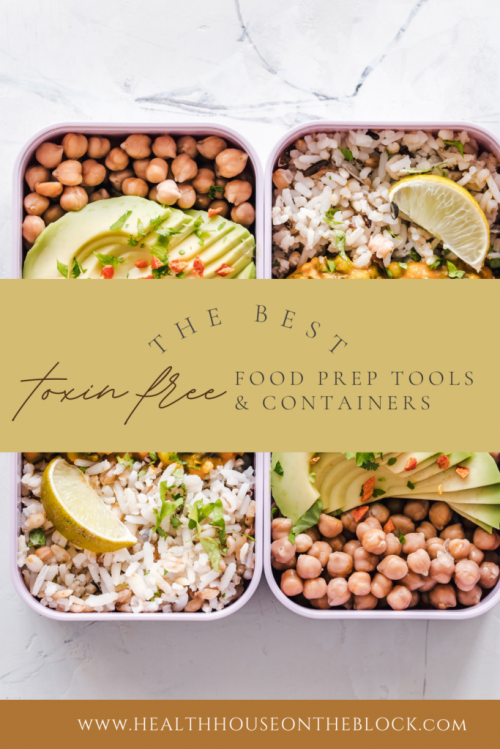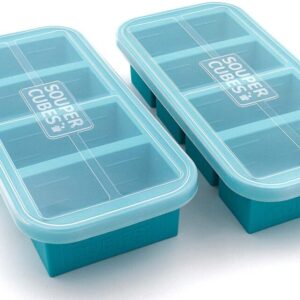
When life gets busy, I meal prep everything. From breakfast to snacks to dinner, it all gets prepared ahead of time so that whoever cooks dinner can just throw it all together. While I actually really love cooking a meal and taking my time, with kids at home, activities after school and work, sometimes we just don’t have the time to do everything at a slow pace. Finding a meal prep container full of tonight’s dinner ingredients takes all the stress out of preparing dinner.
I’ve meal prepped for years and like I said, I will prep snacks and breakfasts too. ANYTHING to make getting out the door easier. When I first started doing this with my first daughter, everything was stored in ziplock bags and plastic containers. I had no idea there was any other option for meal prep containers out there. In fact most everything was plastic from the containers to the cutting board to the bags.
While I didn’t replace everything at once, over the years I’ve slowly swapped out my meal prep containers for healthy alternatives. At the same time, I’ve worked on my meal prep tools and food storage bags at the same time. And even though it felt like I was going at a snail’s pace, I’ve gotten a really good handle on my kitchen and meal prep containers and tools.
And I really think that although a slow swap can be frustrating, it’s really the way to do it. Meal prep containers and meal prep tools can get expensive. Just make sure you have a plan for which items you plan to replace first and just pick away at it. You can watch for sales and replace just one or a few things at a time.
The first items to go should be scratched plastic. After that I would work on plastic meal prep containers that you use for warm food and then plastic food bags. As you slowly replace your meal prep containers with glass or metal, I’m guessing you’ll notice you don’t even need as many containers as you currently have.
If you’re ready to ditch the plastic, then read on for:
- Why you should avoid plastic
- Toxins in plastic meal prep containers
- Healthy meal prep container and tool swaps
- My favorite healthy meal prep ideas

WHY PLASTIC AND FOOD DON’T MIX
Anytime plastic meal prep containers get warm they leach even more toxins into the food that we’ll be consuming. What scientists have found in the last several years is that heat is not the only contributor to how fast the toxins leach into your food.
Other factors to consider are the acidity of the food and the presence of certain vitamins such as Vitamin A. Acidity allows the toxins to migrate into food at a much higher rate than food that has a more alkaline base. In addition, the presence of Vitamin A has been shown to react with the toxins, dissolving them slightly, which increases the migration into our food.
Scratched plastics are another way that toxins can travel into our food through tiny particles that become dislodged and can enter our food, where we consume the plastic pieces.

TOXINS IN PLASTIC MEAL PREP CONTAINERS
Plastic near food, even BPA free plastic, is something I’ve tried to avoid completely. In truth, it’s impossible to do this. But, I do feel much better being able to control what goes on in my own home and avoid plastic wherever I can when it touches food.
Plastic in meal prep containers and food containers can leach chemicals into our food, especially when the plastic is heated or scratched. (Journal of Energy and Environmental Science). Plastic is made up of SO many toxins, more than just BPA. And all of them are hazardous to our health and especially the health of our kids.

One of the biggest toxins that is found in plastic meal prep containers is Formaldehyde. Formaldehyde is a known human carcinogen and has been linked to leukemia in children.
Styrene is another one of the big toxins found in a lot of disposable containers and cutlery. Polystyrene plastic, which is generally opaque in color, contains the highest levels of styrene. Styrene is easily leached into food and migrates at a much faster rate when food has higher fat content, when food or beverages are warmed, and when food has more acidity or Vitamin A. Styrene has been linked to issues with low platelet counts, lymphatic abnormalities, behavioral changes (like anxiety and nervousness) as well as nervous system disorders. (Journal of Energy and Environmental Science)

When PVC is manufactured, dioxin is used in the process. This toxin has confirmed as a known human carcinogen and has also been studied as a endocrine disruptor. The endocrine disrupting that goes on with dioxin is similar to that of phthalates and in the long run can lead to an increased risk of breast cancer. The hormone disruption has also been linked to developmental problems, reproduction problems, and damage to the immune system (National Institute of Environmental Health Sciences)
You might think that just because your plastic is BPA free, it’s safe. But this just isn’t the case when you start to look at the alternative Bisphenol Toxins that are being used. I wrote an entire blog post on the different types of bisphenol toxins that are used to replace BPA. What I found and shared in writing this blog post is that most and what we found is that any plastic that has a replacement bisphenol toxin in it still disrupts hormones in adults, kids and unborn babies. These toxins are estimated to be in 90% of individuals because the body can’t break down the toxin faster than we consume it.
This list is just the big offenders that are in plastic meal prep containers, bags and wraps. Anything in a plastic form is best avoided when it comes to food and eating.

HEALTHY MEAL PREP SWAPS
As always, the good news is that there are plenty of meal prep containers that you can easily and quite affordably swap out. And while you might not do it all at once, having an idea of which replacements you’ll make is so helpful to be prepared.
Meal Prep Containers: Opt for glass or stainless steel metal if you can. If you need disposable, there are also recyclable meal prep containers that you can find.
Plastic Food Bags: Switch to a silicone reusable bag if you can help it. You can also go for a fabric bag that is washable for dry snacks.
Snack Containers: I love metal or silicone containers for small snacks that need to be transported. Remember that food grade silicone or platinum silicone is going to be the safest option. And for metal, try to find a stainless steel
Plastic Wrap: I ditched plastic wrap years ago and I barely even notice that I don’t have it. You can use a suction silicone lid, sandwich paper or a beeswax wrap instead.
Frozen Cubes: Freezing portions of food is such a helpful thing when it comes to meal prep. It’s also a great way to cut down on food waste. We freeze anything from broth and soup to tomato paste for recipes in the future.
Cutting Boards: A cutting board is a MUST for meal prepping. I personally like a flexible cutting board for fruits and veggies. I did a whole post on cutting boards here for all types of healthy options.
Crockpot: I like to make meals ahead and sometimes we use our InstantPot or a crockpot to save on time. I love the InstantPot because it is a stainless steel insert that cooks the food. I’ve also fallen in love with VitaClay, which is a completely toxin free unglazed clay crockpot.
FAVORITE MEAL PREP IDEAS
Make A Rotisserie Chicken at Home: My friend Shawna at A Little Less Toxic shared how she cooks a rotisserie chicken in their instant pot and uses the meat for several meals throughout the week. I tried this a few weeks ago and YES — not only did I use the chicken for meals, but we made delicious bone broth too. Definitely a must try.
Two Meals at Once: So many of our meals have chopped up veggies. I will plan out the week and if veggies need to be chopped for more than one meal, I do it together in order to get it done more efficiently.
Repurpose Dinner Ingredients: So often we have left over more than one component of our meal. For example, potatoes always seem to be leftovers ALWAYS. If they’re baked, we’ll make them into another side like smashed potatoes or twice baked. If we have mashed potatoes left, I love turning them into pierogis for a meal during the week. Chicken, rice and pasta are other ingredients that can be repurposed when they are leftovers.

Once you start pulling plastic from your food and start replacing it with healthier options like glass, metal and silicone, you can really gain momentum and go further into your kitchen. Meal prep containers are a great place to start because they touch our food and often we use them several times throughout the week. But no matter how you go about replacing your plastic, just know that you’re taking a step in the right direction.
Share this:
- Click to share on Facebook (Opens in new window) Facebook
- Click to share on LinkedIn (Opens in new window) LinkedIn
- Click to share on Reddit (Opens in new window) Reddit
- Click to share on Pinterest (Opens in new window) Pinterest
- Click to print (Opens in new window) Print
- Click to share on X (Opens in new window) X





















Pingback: Nine Free Ways to Reduce Environmental Toxins at Home
In this post, you recommend Ball glass jars, but the lids contain toxins. Do you buy separate lids? How do you avoid the toxins in the lids?